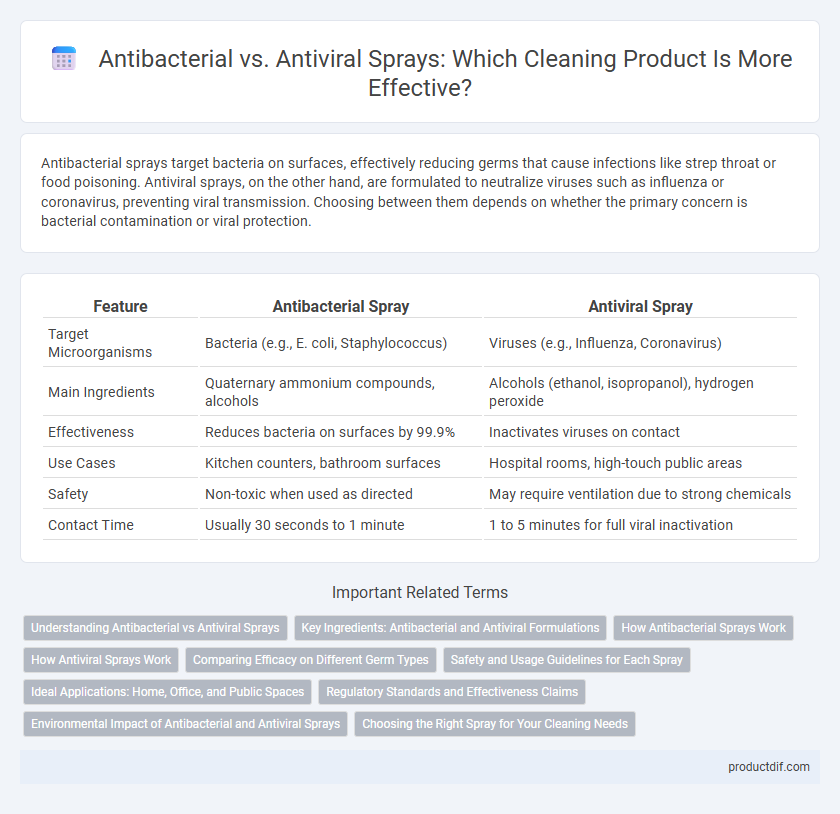Antibacterial sprays target bacteria on surfaces, effectively reducing germs that cause infections like strep throat or food poisoning. Antiviral sprays, on the other hand, are formulated to neutralize viruses such as influenza or coronavirus, preventing viral transmission. Choosing between them depends on whether the primary concern is bacterial contamination or viral protection.
Table of Comparison
| Feature | Antibacterial Spray | Antiviral Spray |
|---|---|---|
| Target Microorganisms | Bacteria (e.g., E. coli, Staphylococcus) | Viruses (e.g., Influenza, Coronavirus) |
| Main Ingredients | Quaternary ammonium compounds, alcohols | Alcohols (ethanol, isopropanol), hydrogen peroxide |
| Effectiveness | Reduces bacteria on surfaces by 99.9% | Inactivates viruses on contact |
| Use Cases | Kitchen counters, bathroom surfaces | Hospital rooms, high-touch public areas |
| Safety | Non-toxic when used as directed | May require ventilation due to strong chemicals |
| Contact Time | Usually 30 seconds to 1 minute | 1 to 5 minutes for full viral inactivation |
Understanding Antibacterial vs Antiviral Sprays
Antibacterial sprays target and eliminate bacteria on surfaces, effectively reducing the risk of bacterial infections, while antiviral sprays are formulated to deactivate or destroy viruses, preventing viral transmission. Understanding the active ingredients such as ethanol or quaternary ammonium compounds in antibacterial sprays and agents like hydrogen peroxide or sodium hypochlorite in antiviral sprays is crucial for proper application. Choosing the correct spray depends on the specific pathogens present and desired sanitation outcomes in environments like healthcare facilities or homes.
Key Ingredients: Antibacterial and Antiviral Formulations
Antibacterial sprays primarily contain ingredients like benzalkonium chloride and triclosan that target and eliminate bacteria by disrupting their cell walls. Antiviral sprays often include active components such as ethanol, isopropanol, or hydrogen peroxide, which are effective in inactivating viruses by breaking down their lipid envelopes or protein coats. Understanding these distinct formulations ensures the appropriate use of sprays for targeting specific pathogens on surfaces.
How Antibacterial Sprays Work
Antibacterial sprays eliminate or inhibit the growth of bacteria by targeting their cell walls and disrupting essential biochemical processes, effectively reducing bacterial contamination on surfaces. These sprays typically contain active ingredients such as benzalkonium chloride or chlorhexidine, which penetrate bacterial membranes and cause cell lysis. Unlike antiviral sprays that specifically deactivate viruses by damaging their protein coats or genetic material, antibacterial sprays are optimized to combat bacteria through cell disruption and inhibition of reproduction.
How Antiviral Sprays Work
Antiviral sprays work by disrupting the lipid envelope or protein coat of viruses, effectively inactivating them on surfaces. These sprays often contain ingredients like ethanol, hydrogen peroxide, or quaternary ammonium compounds that penetrate and destroy viral particles. Unlike antibacterial sprays that target bacterial cell walls, antiviral sprays specifically neutralize viruses, reducing transmission risks in high-contact areas.
Comparing Efficacy on Different Germ Types
Antibacterial sprays target bacteria by disrupting their cell walls or metabolic processes, effectively reducing bacterial contamination on surfaces. In contrast, antiviral sprays are formulated to inactivate viruses by breaking down viral envelopes or denaturing proteins, offering protection against viral pathogens such as influenza and coronaviruses. Efficacy varies as antibacterial sprays may not neutralize viruses effectively, while antiviral sprays often include broader-spectrum agents capable of targeting both viruses and some bacteria.
Safety and Usage Guidelines for Each Spray
Antibacterial sprays target bacteria and are generally safe for use on most household surfaces if applied according to label instructions, avoiding contact with food and skin. Antiviral sprays are formulated to eliminate viruses, often requiring longer contact times and proper ventilation during use to ensure effectiveness while minimizing respiratory irritation. Both sprays demand adherence to usage guidelines such as wearing gloves, avoiding mixing with other chemicals, and ensuring surfaces remain wet for the recommended duration to maximize safety and efficacy.
Ideal Applications: Home, Office, and Public Spaces
Antibacterial sprays target bacteria on surfaces, making them ideal for kitchens, bathrooms, and high-touch areas in homes and offices to prevent bacterial infections. Antiviral sprays are formulated to deactivate viruses, proving essential in public spaces such as hospitals, transit stations, and schools to reduce viral transmission. Selecting the appropriate spray enhances hygiene by addressing specific microbial threats in varied environments.
Regulatory Standards and Effectiveness Claims
Antibacterial sprays are regulated under EPA guidelines requiring specific efficacy against bacteria, while antiviral sprays must meet stricter standards demonstrating effectiveness against viruses, often including claims validated by independent laboratory testing. The FDA may also oversee antiviral sprays categorized as disinfectants, ensuring claims align with clinical evidence for viral inactivation. Consumers should verify that products carry appropriate registrations and certifications reflecting their intended antimicrobial spectrum to ensure safety and effectiveness.
Environmental Impact of Antibacterial and Antiviral Sprays
Antibacterial sprays often contain compounds like triclosan and quaternary ammonium compounds, which can persist in the environment and contribute to antibiotic resistance and aquatic toxicity. Antiviral sprays typically use alcohol-based or hydrogen peroxide formulations that break down more quickly, resulting in a lower ecological footprint. Choosing antiviral sprays with biodegradable ingredients reduces harmful residues and mitigates long-term environmental damage.
Choosing the Right Spray for Your Cleaning Needs
Antibacterial sprays target and eliminate bacteria like E. coli and Salmonella, making them ideal for surfaces prone to bacterial contamination such as kitchen counters and bathroom fixtures. Antiviral sprays are formulated to deactivate viruses including influenza and coronaviruses, essential for disinfecting high-touch areas during viral outbreaks. Selecting the right spray depends on the specific pathogens you aim to combat and the environment where the spray will be applied, ensuring effective protection and hygiene.
Antibacterial spray vs antiviral spray Infographic

 productdif.com
productdif.com